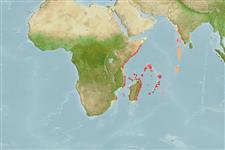Teleostei (teleosts) >
Gobiiformes (Gobies) >
Gobiidae (Gobies) > Gobiinae
Etymology: Hetereleotris: Greek, heteros = other + The name of a Nile fish, eleotris (Ref. 45335).
More on author: Smith.
Environment: milieu / climate zone / depth range / distribution range
Ecology
Marine; demersal. Tropical
Western Indian Ocean: East Africa, Reunion, and Rodriguez.
Size / Weight / Age
Maturity: Lm ? range ? - ? cm
Max length : 4.1 cm TL male/unsexed; (Ref. 36670)
Short description
Identification keys | Morphology | Morphometrics
Scales larger longitudinal scale count 32-33; body with 4-6 brown vertical bands (Ref. 57078).
Life cycle and mating behavior
Maturity | Reproduction | Spawning | Eggs | Fecundity | Larvae
Fricke, R., 1999. Fishes of the Mascarene Islands (Réunion, Mauritius, Rodriguez): an annotated checklist, with descriptions of new species. Koeltz Scientific Books, Koenigstein, Theses Zoologicae, Vol. 31:759 p. (Ref. 33390)
IUCN Red List Status (Ref. 130435: Version 2024-1)
Threat to humans
Harmless
Human uses
Tools
Special reports
Download XML
Internet sources
Estimates based on models
Preferred temperature (Ref.
123201): 25 - 28.7, mean 27.1 °C (based on 264 cells).
Phylogenetic diversity index (Ref.
82804): PD
50 = 0.5000 [Uniqueness, from 0.5 = low to 2.0 = high].
Bayesian length-weight: a=0.00955 (0.00355 - 0.02566), b=3.03 (2.80 - 3.26), in cm total length, based on LWR estimates for this (Sub)family-body shape (Ref.
93245).
Trophic level (Ref.
69278): 3.1 ±0.3 se; based on size and trophs of closest relatives
Resilience (Ref.
120179): High, minimum population doubling time less than 15 months (Preliminary K or Fecundity.).
Fishing Vulnerability (Ref.
59153): Low vulnerability (10 of 100).
